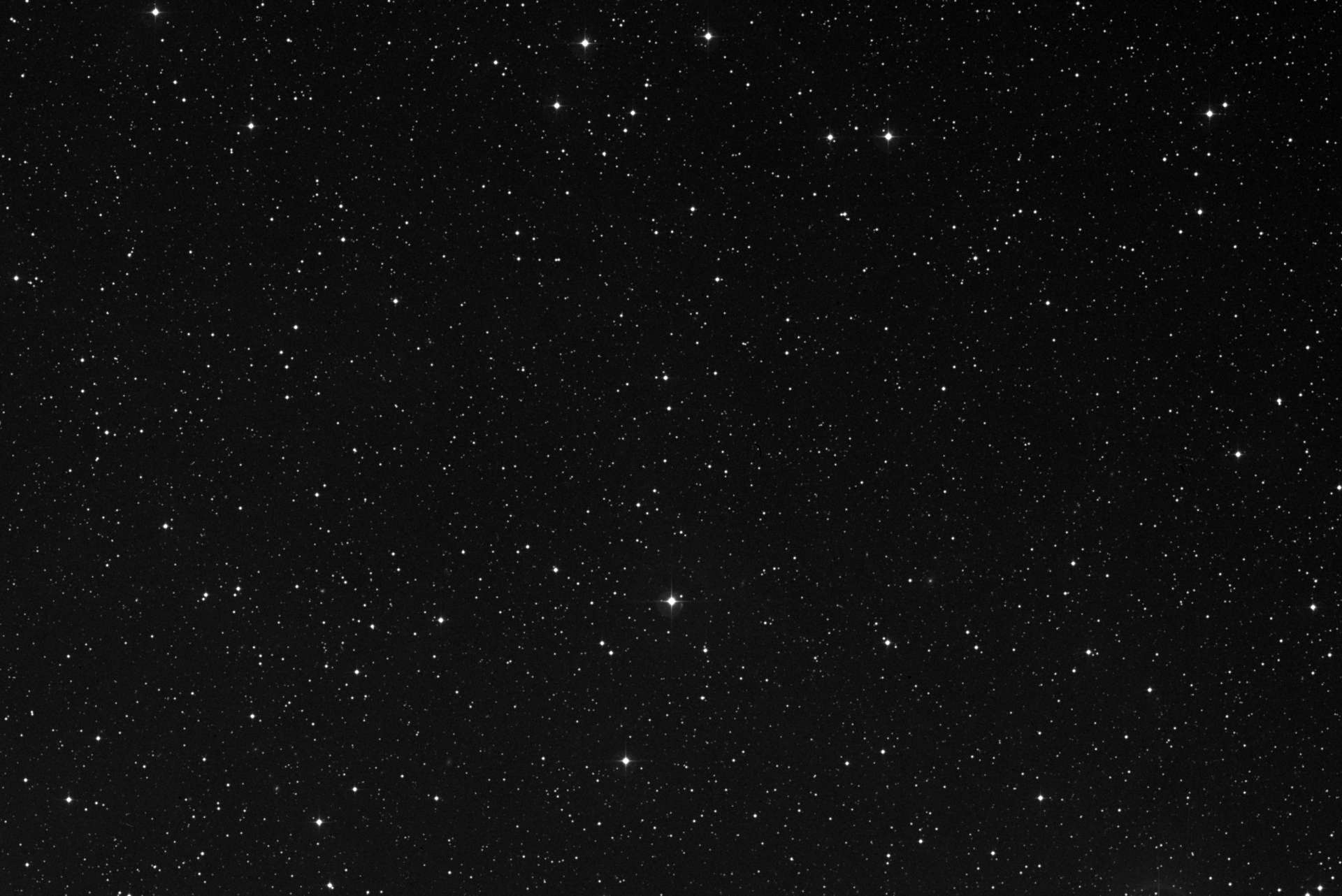
- Object Information
- Planetarium


Voyager 1 live position and data
This page shows Voyager 1 location and other relevant astronomical data in real time. The celestial coordinates, magnitude, distances and speed are updated in real time and are computed using high quality data sets provided by the JPL Horizons ephemeris service (see acknowledgements for details). The sky map shown in the background represents a rectangular portion of the sky 60x40 arcminutes wide. By comparison the diameter of the full Moon is about 30 arcmins, so the full horizontal extent of the map is approximately 2 full Moons wide. Depending on the device you are using, the map can be dragged horizondally or vertically using the mouse or touchscreen. The deep sky image in the background is provided by the Digitized Sky Survey ( acknowledgements ).
Current close conjunctions
List of bright objects (stars brighter than magnitude 9.0 and galaxies brighter than magmitude 14.0) close to Voyager 1 (less than 1.5 degrees):
Additional resources
- 15 Days Ephemerides
- Interactive Sky Map (Planetarium)
- Rise & Set Times
- Distance from Earth
Astronomy databases
- The Digitized Sky Survey, a photographic survey of the whole sky created using images from different telescopes, including the Oschin Schmidt Telescope on Palomar Mountain
- The Hipparcos Star Catalogue, containing more than 100.000 bright stars
- The PGC 2003 Catalogue, containing information about 1 million galaxies
- The GSC 2.3 Catalogue, containing information about more than 2 billion stars and galaxies
Voyager 1 Trajectory through the Solar System
- Released Thursday, August 31, 2017
- Visualizations by:
- Tom Bridgman
This visualization tracks the trajectory of the Voyager 1 spacecraft through the solar system. Launched on September 5, 1977, it was one of two spacecraft sent to visit the giant planets of the outer solar system. Voyager 1 flew by Jupiter and Saturn before being directed out of the solar system. To fit the 40 year history of the mission into a short visualization, the pacing of time accelerates through most of the movie, starting at about 5 days per second at the beginning and speeding up to about 11 months per second after the planet flybys are past. The termination shock and heliopause are the 'boundaries' created when the plasma between the stars interacts with the plasma flowing outward from the Sun. They are represented with simple grid models and oriented so their 'nose' is pointed in the direction (Right Ascension = 17h 24m, declination = 17 degrees south) represented by more recent measurements from other missions.
Visualization centered on the Voyager 1 trajectory through the solar system.
- Voyager.ChaseV1.HD1080i_p30.mp4 (1920x1080) [120.3 MB]
- Voyager.ChaseV1.HD1080i_p30.webm (1920x1080) [15.4 MB]
- Voyager.ChaseV1.clockSlate_2160p30.mp4 (3840x2160) [210.8 MB]
- Voyager.ChaseV1.clockSlate (1920x1080) [256.0 KB]
- Voyager.ChaseV1.clockSlate (3840x2160) [256.0 KB]
- Voyager.ChaseV1.clockSlate_Track.HD1080i.03905_print.jpg (1024x576) [96.8 KB]
- Voyager.ChaseV1.clockSlate_Track.HD1080i.03905_searchweb.png (320x180) [68.6 KB]
- Voyager.ChaseV1.clockSlate_Track.HD1080i.03905_thm.png (80x40) [4.4 KB]
Voyager 1's 'Family Portrait' On Valentine's Day 1990, Voyager 1's camera were pointed back at the solar system to image the planets. Check out Voyager at NASA/JPL for more information.
- Voyager.ChaseV1.clockSlate_Track.UHD3840.00000_print.jpg (1024x576) [104.9 KB]
Opening view of Earth orbit looking outward to the rest of the solar system.
- Voyager.ChaseV1.clockSlate_Track.UHD3840.00550_print.jpg (1024x576) [117.4 KB]
Voyager 1 (and 2) cross the orbit of Mars, slightly above the ecliptic plane to avoid the asteroid belt between Mars & Jupiter.
- Voyager.ChaseV1.clockSlate_Track.UHD3840.01490_print.jpg (1024x576) [113.3 KB]
The camera moves out ahead of the Voyagers for a view back at the inner solar system.
- Voyager.ChaseV1.clockSlate_Track.UHD3840.01990_print.jpg (1024x576) [102.3 KB]
Voyager 1 just after the Jupiter flyby on March 5, 1979.
- Voyager.ChaseV1.clockSlate_Track.UHD3840.02420_print.jpg (1024x576) [101.8 KB]
Voyager 1 just before the Saturn flyby on November 12, 1980.
- Voyager.ChaseV1.clockSlate_Track.UHD3840.02990_print.jpg (1024x576) [123.1 KB]
With a gravity-assist from the Saturn flyby, Voyager 1 is directed above the plane of the solar system and continues outward. This is near the time of the Voyager 1 'Family Portrait'. The orbit of Pluto is the grey orbit visible above the orbits of the other planets.
- Voyager.ChaseV1.clockSlate_Track.UHD3840.03350_print.jpg (1024x576) [97.5 KB]
Voyager 1 crosses the termination shock of the solar wind. For simplified and symmetric termination shock model, the timing is not accurate. In reality, this crossing occurred around December of 2004.
- Voyager.ChaseV1.clockSlate_Track.UHD3840.03900_print.jpg (1024x576) [99.4 KB]
Voyager 1 (and 2) beyond the heliopause near the end of 2017.
A slightly sped-up version of the Voyager 1 visualization above, reducing the time for the Voyagers to cross the asteroid belt.
- Voyager1SpedUp.m4v (1920x1080) [123.0 MB]
- Voyager1SpedUp.webm (1920x1080) [12.2 MB]
- Voyager1_Sped_Up-HD1080p.mov (1920x1080) [185.8 MB]
- Voyager1_Sped_Up.mov (1920x1080) [1.7 GB]
- Voyager_1_Sped_Up_4k-H264.mov (3840x2160) [639.6 MB]
- Voyager_1_Sped_Up_4k_ProRes.mov (3840x2160) [7.2 GB]
- Voyager1SpedUp.00500_print.jpg (1024x576) [122.6 KB]
- Solar System
Please give credit for this item to: NASA's Scientific Visualization Studio
- Tom Bridgman (Global Science and Technology, Inc.)
- Kathalina Tran (KBR Wyle Services, LLC)
- Genna Duberstein (USRA)
- Scott Wiessinger (USRA)
Project support
- Laurence Schuler (ADNET Systems, Inc.)
- Ian Jones (ADNET Systems, Inc.)
Release date
This page was originally published on Thursday, August 31, 2017. This page was last updated on Wednesday, November 15, 2023 at 12:05 AM EST.
- Voyager @ 40
- Voyager Retrospective
Datasets used in this visualization
Planetary ephemerides SPICE kernel
Note: While we identify the data sets used in these visualizations, we do not store any further details, nor the data sets themselves on our site.
Hubble’s Brand New Image of Jupiter
Where is the edge of the solar system, voyager 2 trajectory through the solar system, revisiting the pale blue dot at 30, you may also like..., no results., an error occurred. please reload this page and try again..
- Skip to main content
- Keyboard shortcuts for audio player
Well, hello, Voyager 1! The venerable spacecraft is once again making sense

Nell Greenfieldboyce

Members of the Voyager team celebrate at NASA's Jet Propulsion Laboratory after receiving data about the health and status of Voyager 1 for the first time in months. NASA/JPL-Caltech hide caption
Members of the Voyager team celebrate at NASA's Jet Propulsion Laboratory after receiving data about the health and status of Voyager 1 for the first time in months.
NASA says it is once again able to get meaningful information back from the Voyager 1 probe, after months of troubleshooting a glitch that had this venerable spacecraft sending home messages that made no sense.
The Voyager 1 and Voyager 2 probes launched in 1977 on a mission to study Jupiter and Saturn but continued onward through the outer reaches of the solar system. In 2012, Voyager 1 became the first spacecraft to enter interstellar space, the previously unexplored region between the stars. (Its twin, traveling in a different direction, followed suit six years later.)
Voyager 1 had been faithfully sending back readings about this mysterious new environment for years — until November, when its messages suddenly became incoherent .

NASA's Voyager 1 spacecraft is talking nonsense. Its friends on Earth are worried
It was a serious problem that had longtime Voyager scientists worried that this historic space mission wouldn't be able to recover. They'd hoped to be able to get precious readings from the spacecraft for at least a few more years, until its power ran out and its very last science instrument quit working.
For the last five months, a small team at NASA's Jet Propulsion Laboratory in California has been working to fix it. The team finally pinpointed the problem to a memory chip and figured out how to restore some essential software code.
"When the mission flight team heard back from the spacecraft on April 20, they saw that the modification worked: For the first time in five months, they have been able to check the health and status of the spacecraft," NASA stated in an update.
The usable data being returned so far concerns the workings of the spacecraft's engineering systems. In the coming weeks, the team will do more of this software repair work so that Voyager 1 will also be able to send science data, letting researchers once again see what the probe encounters as it journeys through interstellar space.

After a 12.3 billion-mile 'shout,' NASA regains full contact with Voyager 2
- interstellar mission
The remarkable twin Voyager spacecraft continue to explore the outer reaches of the solar system decades after they completed their surveys of the Outer Planets. Launched in 1977 (September 5 for Voyager 1 (V1) and August 20 for Voyager 2 (V2), whose trajectory took it past Jupiter after Voyager 1), the spacecraft pair made many fundamental discoveries as they flew past Jupiter (March 1979 for V1, July 1979 for V2) and Saturn (November 1980 for V1, August 1981 for V2). The path of Voyager 2 past Saturn was targeted so that it continued within the plane of the solar system, allowing it to become the first spacecraft to visit Uranus (January 1986) and Neptune (August 1989). Following the Neptune encounter, both spacecraft started a new phase of exploration under the intriguing title of the Voyager Interstellar Mission.
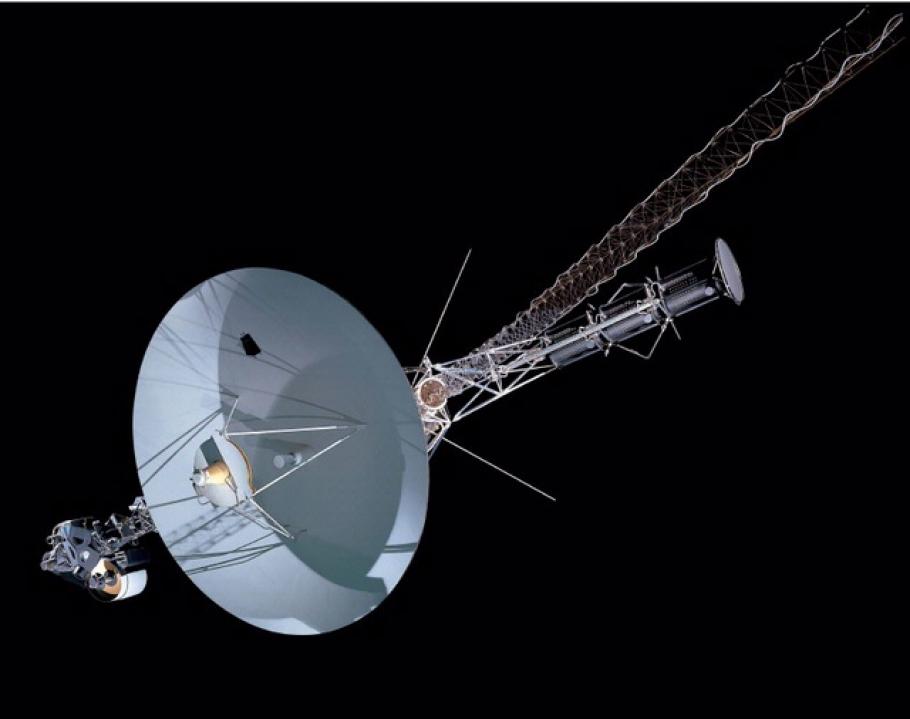
Five instruments continue to collect important measurements of magnetic fields, plasmas, and charged particles as both spacecraft explore different portions of the solar system beyond the orbits of the planets. Voyager 1 is now more than 118 astronomical units (one AU is equal to the average orbital distance of Earth from the Sun) distant from the sun, traveling at a speed (relative to the sun) of 17.1 kilometers per second (10.6 miles per second). Voyager 2 is now more than 96 AU from the sun, traveling at a speed of 15.5 kilometers per second (9.6 miles per second). Both spacecraft are moving considerably faster than Pioneers 10 and 11, two earlier spacecraft that became the first robotic visitors to fly past Jupiter and Saturn in the mid-70s.
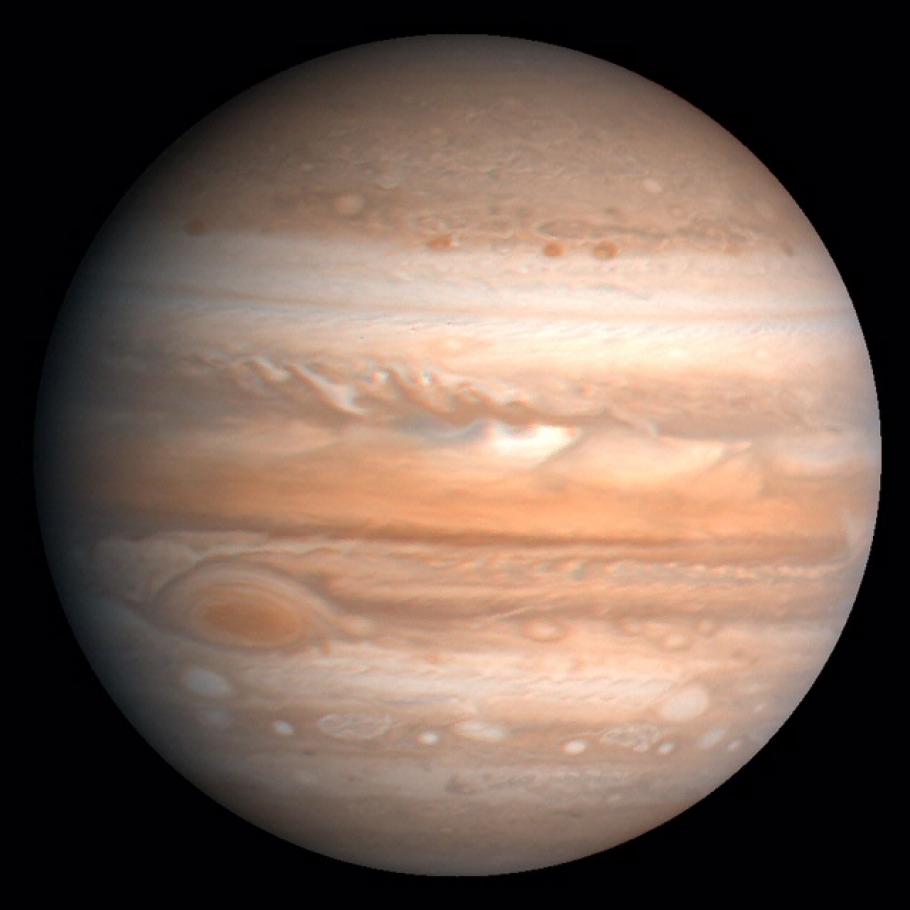
This processed color image of Jupiter was produced in 1990 by the U.S. Geological Survey from a Voyager image captured in 1979. The colors have been enhanced to bring out detail. Zones of light-colored, ascending clouds alternate with bands of dark, descending clouds. The clouds travel around the planet in alternating eastward and westward belts at speeds of up to 540 kilometers per hour. Tremendous storms as big as Earthly continents surge around the planet. The Great Red Spot (oval shape toward the lower-left) is an enormous anticyclonic storm that drifts along its belt, eventually circling the entire planet.
As seen in the night sky at Earth, Voyager 1 is within the confines of the constellation Ophiuchus, only slightly above the celestial equator; no telescope can see it, but radio contact is expected to be maintained for at least the next ten years. Voyager 2 is within the bounds of the constellation Telescopium (which somehow sounds quite appropriate) in the far southern night sky.
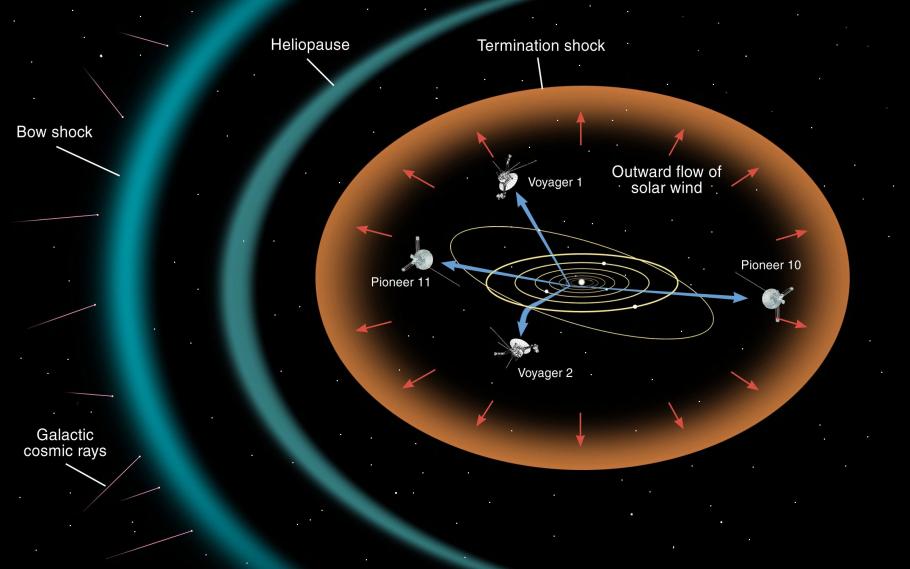
Both spacecraft have already passed something called the Termination Shock † (December 2004 for V1, August 2007 for V2), where the solar wind slows as it starts to interact with the particles and fields present between the stars. It is expected that both spacecraft will encounter the Heliopause, where the solar wind ceases as true interstellar space begins, from 10 to 20 years after crossing the Termination Shock. Theories exist for what should be present in interstellar space, but the Voyagers will become the first man-made objects to go beyond the influences of the Sun, hopefully returning the first measurements of what it is like out there. Each spacecraft is carrying a metal record with encoded sounds and sights from Earth, along with the needle needed to read the recordings, and simplified instructions for where the spacecraft came from, in case they are eventually discovered by intelligent extra-terrestrials.
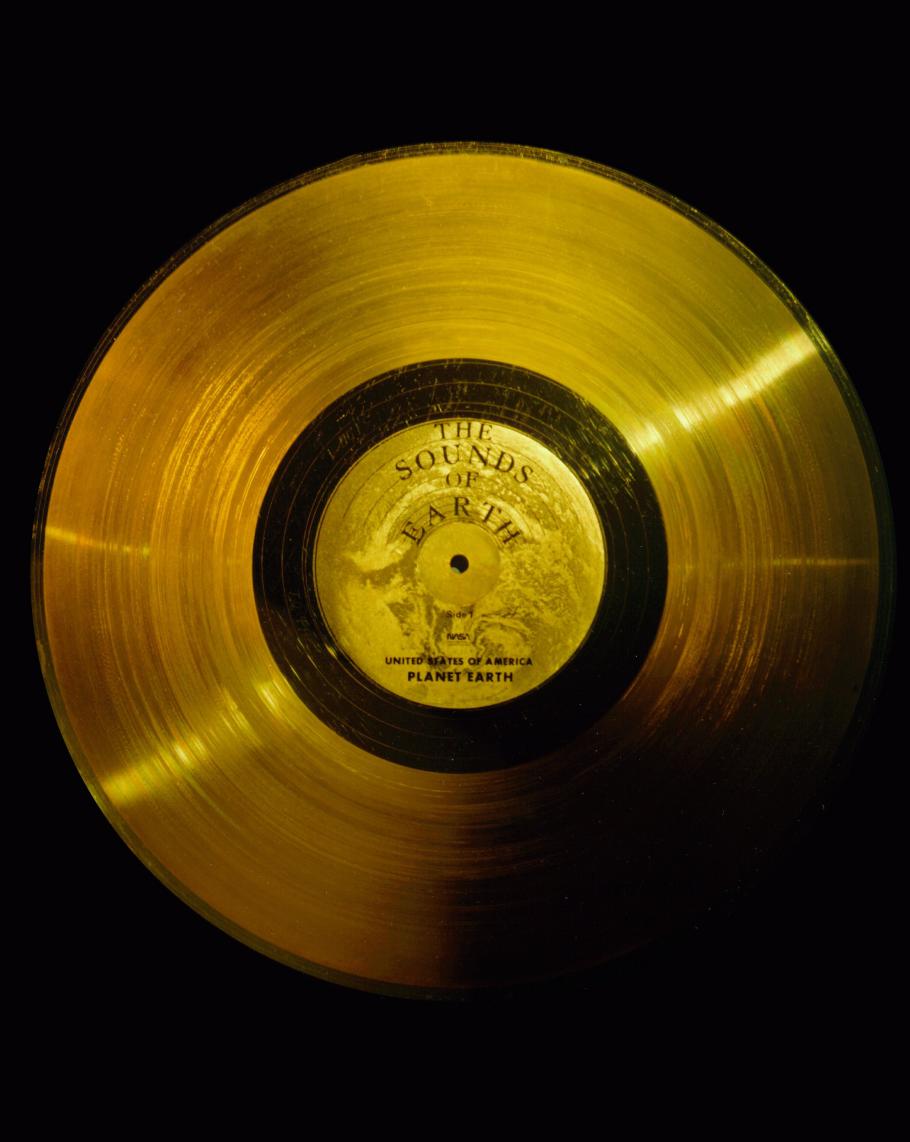
Keep track of the Voyager spacecraft on the official Voyager Interstellar Mission website or follow @NASAVoyager2 on Twitter. † The sun ejects a continuous stream of charged particles (electrons, protons, etc) that is collectively termed the solar wind. The particles are traveling extremely fast and are dense enough to form a very tenuous atmosphere; the heliosphere represents the volume of space where the effects of the solar wind dominate over those of particles in interstellar space. The solar wind particles are moving very much faster than the local speed of sound represented by their low volume density. When the particles begin to interact with interstellar particles and fields (the interaction can be either physically running into other particles or experiencing an electromagnetic force resulting from a charged particle moving within a magnetic field), then they start to slow down. The point at which they become subsonic (rather than their normal hypersonic speed) is the Termination Shock.
We rely on the generous support of donors, sponsors, members, and other benefactors to share the history and impact of aviation and spaceflight, educate the public, and inspire future generations. With your help, we can continue to preserve and safeguard the world’s most comprehensive collection of artifacts representing the great achievements of flight and space exploration.
- Get Involved
- Host an Event
Thank you. You have successfully signed up for our newsletter.
Error message, sorry, there was a problem. please ensure your details are valid and try again..
- Free Timed-Entry Passes Required
- Terms of Use

Suggested Searches
- Climate Change
- Expedition 64
- Mars perseverance
- SpaceX Crew-2
- International Space Station
- View All Topics A-Z
Humans in Space
Earth & climate, the solar system, the universe, aeronautics, learning resources, news & events.

NASA Wins 6 Webby Awards, 8 Webby People’s Voice Awards

NASA’s CloudSat Ends Mission Peering Into the Heart of Clouds

Hubble Celebrates 34th Anniversary with a Look at the Little Dumbbell Nebula
- Search All NASA Missions
- A to Z List of Missions
- Upcoming Launches and Landings
- Spaceships and Rockets
- Communicating with Missions
- James Webb Space Telescope
- Hubble Space Telescope
- Why Go to Space
- Astronauts Home
- Commercial Space
- Destinations
- Living in Space
- Explore Earth Science
- Earth, Our Planet
- Earth Science in Action
- Earth Multimedia
- Earth Science Researchers
- Pluto & Dwarf Planets
- Asteroids, Comets & Meteors
- The Kuiper Belt
- The Oort Cloud
- Skywatching
- The Search for Life in the Universe
- Black Holes
- The Big Bang
- Dark Energy & Dark Matter
- Earth Science
- Planetary Science
- Astrophysics & Space Science
- The Sun & Heliophysics
- Biological & Physical Sciences
- Lunar Science
- Citizen Science
- Astromaterials
- Aeronautics Research
- Human Space Travel Research
- Science in the Air
- NASA Aircraft
- Flight Innovation
- Supersonic Flight
- Air Traffic Solutions
- Green Aviation Tech
- Drones & You
- Technology Transfer & Spinoffs
- Space Travel Technology
- Technology Living in Space
- Manufacturing and Materials
- Science Instruments
- For Kids and Students
- For Educators
- For Colleges and Universities
- For Professionals
- Science for Everyone
- Requests for Exhibits, Artifacts, or Speakers
- STEM Engagement at NASA
- NASA's Impacts
- Centers and Facilities
- Directorates
- Organizations
- People of NASA
- Internships
- Our History
- Doing Business with NASA
- Get Involved
- Aeronáutica
- Ciencias Terrestres
- Sistema Solar
- All NASA News
- Video Series on NASA+
- Newsletters
- Social Media
- Media Resources
- Upcoming Launches & Landings
- Virtual Events
- Sounds and Ringtones
- Interactives
- STEM Multimedia

Sols 4166-4167: A Garden Full of Rocks

European Service Module

Gateway: Frequently Asked Questions

NASA Shares Lessons of Human Systems Integration with Industry

Work Underway on Large Cargo Landers for NASA’s Artemis Moon Missions

NASA Open Science Initiative Expands OpenET Across Amazon Basin

Amendment 11: Physical Oceanography not solicited in ROSES-2024

NASA Data Helps Beavers Build Back Streams

Sols 4164-4165: What’s Around the Ridge-bend?

Sols 4161-4163: Double Contact Science

NASA’s Chandra Releases Doubleheader of Blockbuster Hits

Explore the Universe with the First E-Book from NASA’s Fermi

Dr. Douglas Hudgins

NASA Photographer Honored for Thrilling Inverted In-Flight Image

NASA’s Ingenuity Mars Helicopter Team Says Goodbye … for Now

NASA Langley Team to Study Weather During Eclipse Using Uncrewed Vehicles

NASA’s Near Space Network Enables PACE Climate Mission to ‘Phone Home’

Amendment 10: B.9 Heliophysics Low-Cost Access to Space Final Text and Proposal Due Date.

NASA STEM Artemis Moon Trees

NASA Glenn Joins Big Hoopla STEM Challenge

NASA Mentors, Students Rock FIRST Buckeye Regional

First NASA Mars Analog Crew Nears End of Mission

Diez maneras en que los estudiantes pueden prepararse para ser astronautas

Astronauta de la NASA Marcos Berríos

Resultados científicos revolucionarios en la estación espacial de 2023
45 years ago: voyager 1 begins its epic journey to the outer planets and beyond, johnson space center.
Forty-five years ago, the Voyager 1 spacecraft began an epic journey that continues to this day. The second of a pair of spacecraft, Voyager 1 lifted off on Sept. 5, 1977, 16 days after its twin left on a similar voyage. NASA’s Jet Propulsion Laboratory (JPL) in Pasadena, California, managed the two spacecraft on their missions to explore the outer planets. Taking advantage of a rare planetary alignment to use the gravity of one planet to redirect the spacecraft to the next, the Voyagers planned to use Jupiter’s gravity to send them on to explore Saturn and its large moon Titan. They carried sophisticated instruments to conduct their in-depth explorations of the giant planets. Both spacecraft continue to return data as they make their way out of our solar system and enter interstellar space.
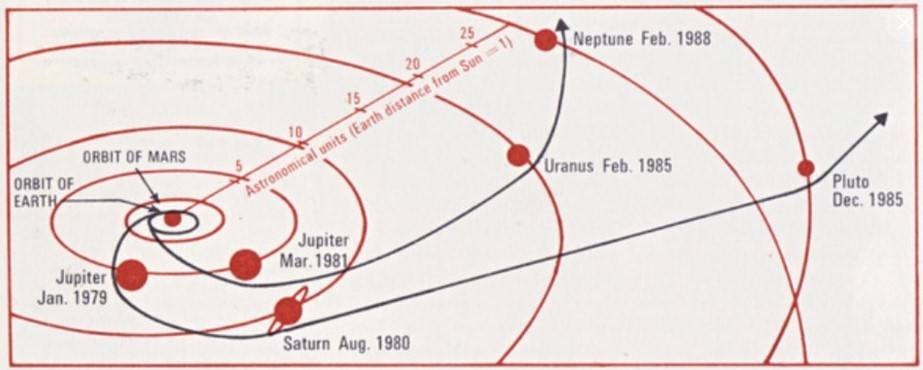
In the 1960s, mission designers at JPL noted that the next occurrence of a once-every-175-year alignment of the outer planets would happen in the late 1970s. A spacecraft could take advantage of this opportunity to fly by Jupiter and use its gravity to bend its trajectory to visit Saturn, and repeat the process to also visit Uranus, Neptune, and Pluto. Launching several missions to visit each planet individually would take much longer and cost much more. The original plan to send two pairs of Thermoelectric Outer Planet Spacecraft on these Grand Tours proved too costly leading to its cancellation in 1971. The next year, NASA approved a scaled-down version of the project to send a pair of Mariner-class spacecraft in 1977 to explore just Jupiter and Saturn, with an expected five-year operational life. On March 7, 1977, NASA Administrator James C. Fletcher announced the renaming of these Mariner Jupiter/Saturn 1977 spacecraft as Voyager 1 and 2. Scientists held out hope that one of them could ultimately visit Uranus and Neptune, thereby fulfilling most of the original Grand Tour’s objectives – Pluto would have to wait several decades for its first visit.
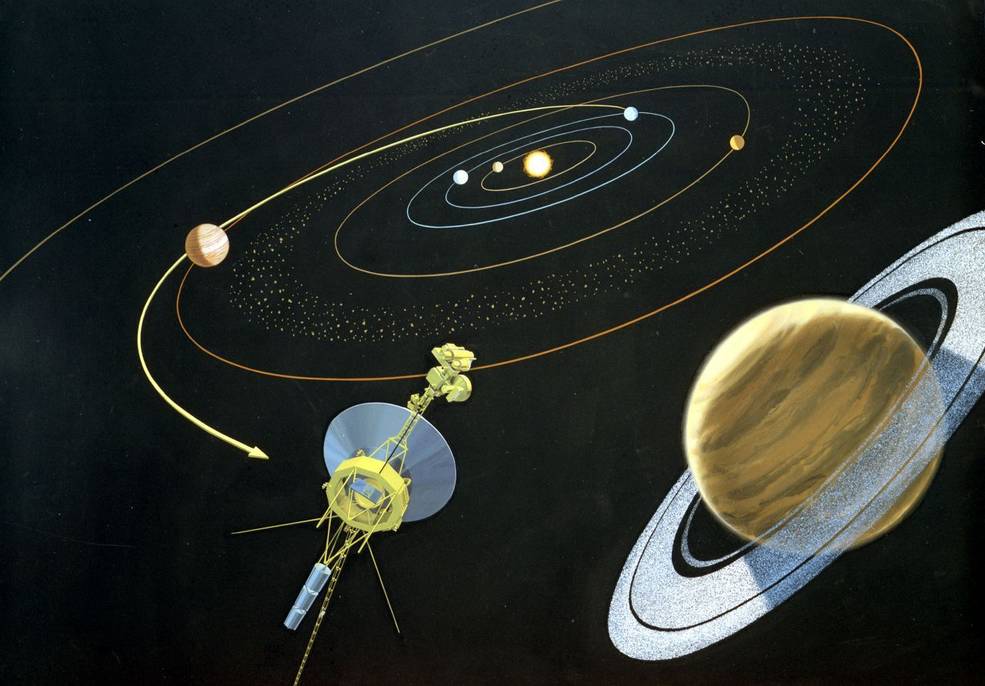
Each Voyager carried a suite of 11 instruments to study the planets during each encounter and to learn more about interplanetary space in the outer reaches of the solar system, including:
- An imaging science system consisting of narrow-angle and wide-angle cameras to photograph the planet and its satellites.
- A radio science system to determine the planet’s physical properties.
- An infrared interferometer spectrometer to investigate local and global energy balance and atmospheric composition.
- An ultraviolet spectrometer to measure atmospheric properties.
- A magnetometer to analyze the planet’s magnetic field and interaction with the solar wind.
- A plasma spectrometer to investigate microscopic properties of plasma ions.
- A low-energy charged particle device to measure fluxes and distributions of ions.
- A cosmic ray detection system to determine the origin and behavior of cosmic radiation.
- A planetary radio astronomy investigation to study radio emissions from Jupiter.
- A photopolarimeter to measure the planet’s surface composition.
- A plasma wave system to study the planet’s magnetosphere.
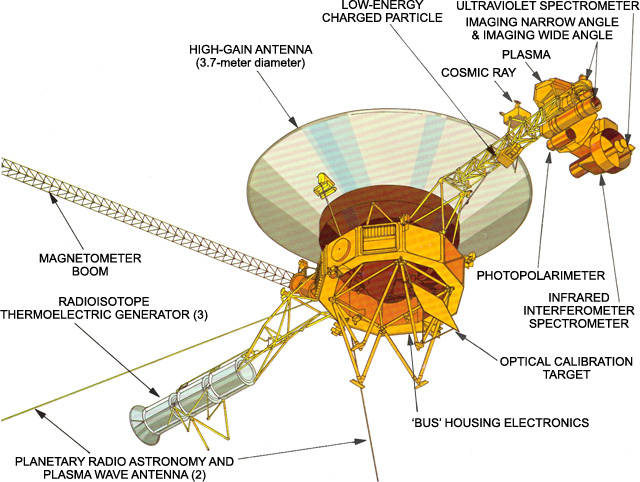
Voyager 1 lifted off on Sept. 5, 1977, atop a Titan IIIE-Centaur rocket from Launch Complex 41 at Cape Canaveral Air Force Station, now Cape Canaveral Space Force Station, in Florida. Two weeks after its launch, from a distance of 7.25 million miles, Voyager 1 turned its camera back toward its home planet and took the first single-frame image of the Earth-Moon system. The spacecraft successfully crossed the asteroid belt between Dec. 10, 1977, and Sept. 8, 1978.
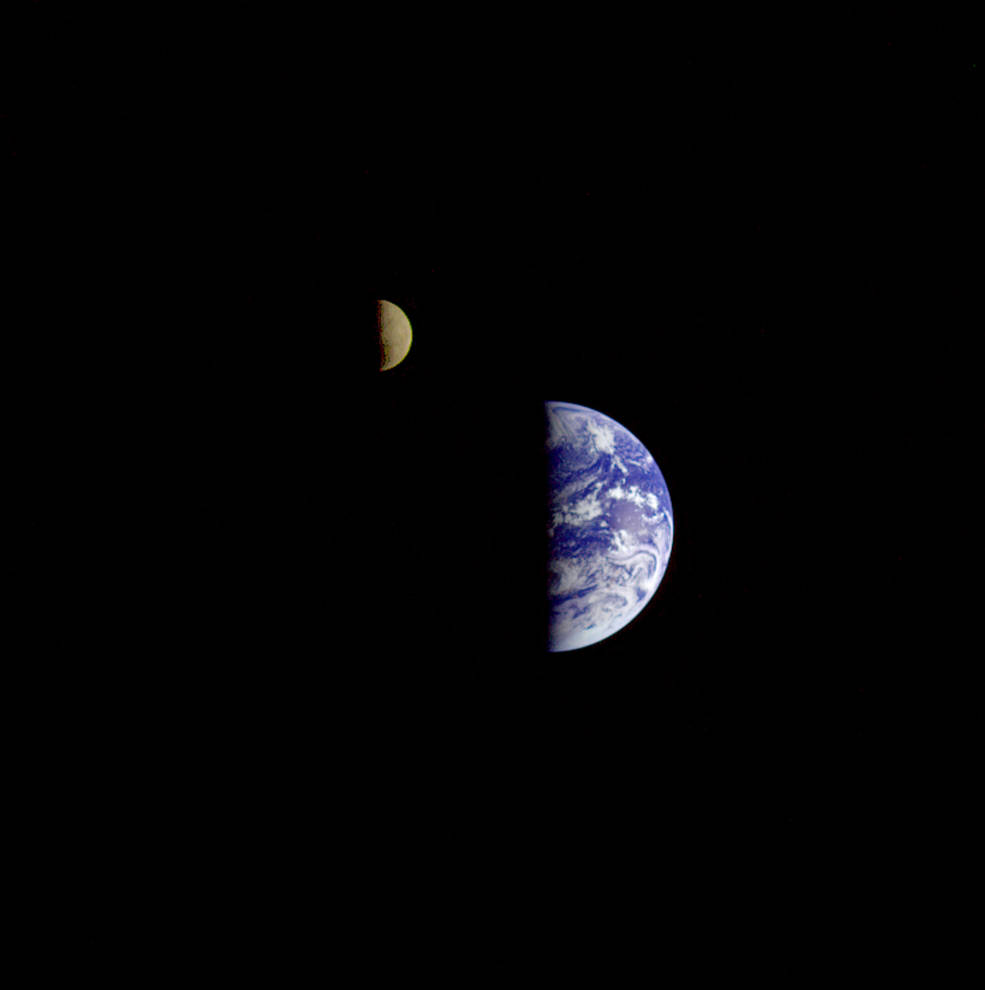
Although Voyager 1 launched two weeks after its twin, it traveled on a faster trajectory and arrived at Jupiter four months earlier. Voyager 1 conducted its observations of Jupiter between Jan. 6 and April 13, 1979, making its closest approach of 216,837 miles from the planet’s center on March 5. The spacecraft returned 19,000 images of the giant planet, many of Jupiter’s satellites, and confirmed the presence of a thin ring encircling it. Its other instruments returned information about Jupiter’s atmosphere and magnetic field. Jupiter’s massive gravity field bent the spacecraft’s trajectory and accelerated it toward Saturn.
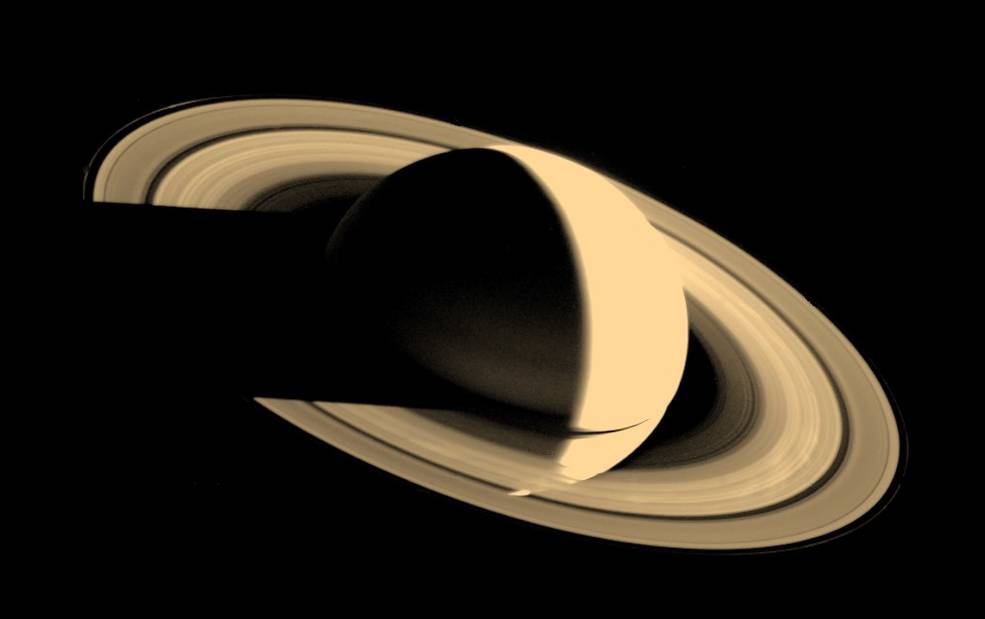
Voyager 1 began its long-range observations of Saturn on Aug. 22, 1980, passed within 114,500 miles of the planet’s center on Nov. 12, and concluded its studies on Dec. 14. Because of its interest to scientists, mission planners chose the spacecraft’s trajectory to make a close flyby of Saturn’s largest moon Titan – the only planetary satellite with a dense atmosphere – just before the closest approach to the planet itself. This trajectory, passing over Saturn’s south pole and bending north over the plane of the ecliptic, precluded Voyager 1 from making any additional planetary encounters. The spacecraft flew 4,033 miles from Titan’s center, returning images of its unbroken orange atmosphere and high-altitude blue haze layer. During the encounter, Voyager 1 returned 16,000 photographs, imaging Saturn, its rings, many of its known satellites and discovering several new ones, while its instruments returned data about Saturn’s atmosphere and magnetic field.

On Feb. 14, 1990, more than 12 years after it began its journey from Earth and shortly before controllers permanently turned off its cameras to conserve power, Voyager 1 spun around and pointed them back into the solar system. In a mosaic of 60 images, it captured a “family portrait” of six of the solar system’s planets, including a pale blue dot called Earth more than 3.7 billion miles away. Fittingly, these were the last pictures returned from either Voyager spacecraft. On Feb. 17, 1998, Voyager 1 became the most distant human-made object, overtaking the Pioneer 10 spacecraft on their way out of the solar system. In February 2020, to commemorate the photograph’s 30th anniversary, NASA released a remastered version of the image of Earth as Pale Blue Dot Revisited .
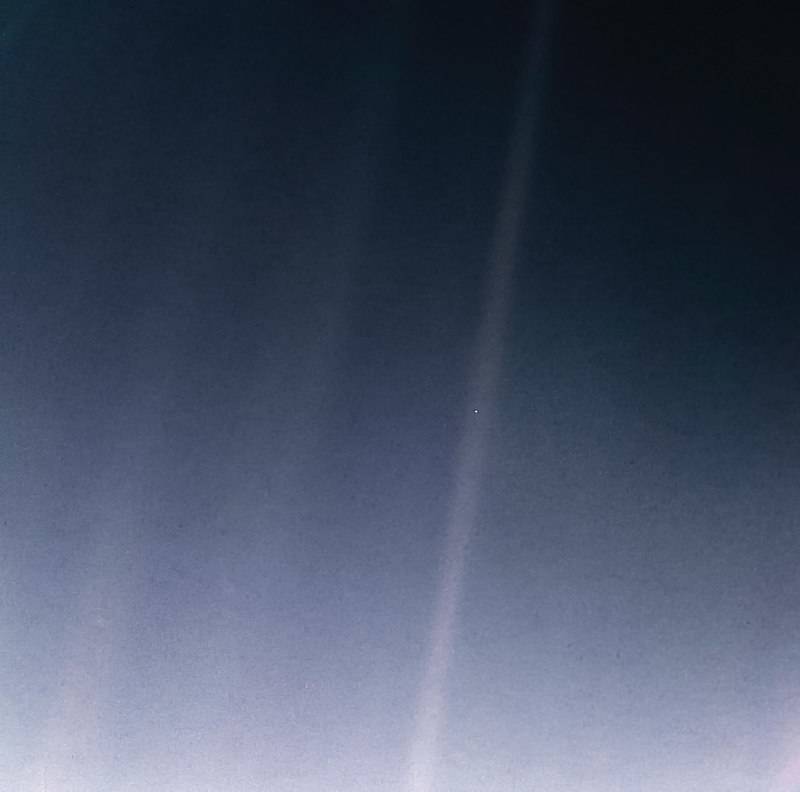
On New Year’s Day 1990, both spacecraft officially began the Voyager Interstellar Mission as they inexorably made their escape from our solar system. On Aug. 25, 2012, Voyager 1 passed beyond the heliopause, the boundary between the heliosphere, the bubble-like region of space created by the Sun, and the interstellar medium. Its twin followed suit six years later. Today , 45 years after its launch and 14.6 billion miles from Earth, four of Voyager 1’s 11 instruments continue to return useful data, having now spent 10 years in interstellar space. Signals from the spacecraft take nearly 22 hours to reach Earth, and 22 hours for Earth-based signals to reach the spacecraft. Engineers expect that the spacecraft will continue to return data from interstellar space until about 2025 when it will no longer be able to power its systems. And just in case an alien intelligence finds it one day, Voyager 1 like its twin carries a gold-plated record that contains information about its home planet, including recordings of terrestrial sounds, music, and greetings in 55 languages. Engineers at NASA thoughtfully included Instructions on how to play the record.
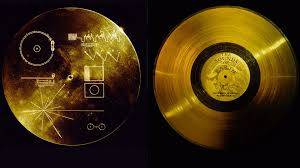
The voyage continues…
Breaking News
After months of silence, Voyager 1 has returned NASA’s calls

- Show more sharing options
- Copy Link URL Copied!
For the last five months, it seemed very possible that a 46-year-old conversation had finally reached its end.
Since its launch from Kennedy Space Center on Sept. 5, 1977, NASA’s Voyager 1 spacecraft has diligently sent regular updates to Earth on the health of its systems and data collected from its onboard instruments.
But in November, the craft went quiet.
Voyager 1 is now some 15 billion miles away from Earth. Somewhere in the cold interstellar space between our sun and the closest stars, its flight data system stopped communicating with the part of the probe that allows it to send signals back to Earth. Engineers at the Jet Propulsion Laboratory in La Cañada Flintridge could tell that Voyager 1 was getting its messages, but nothing was coming back.
“We’re to the point where the hardware is starting to age,” said Linda Spilker, the project scientist for the Voyager mission. “It’s like working on an antique car, from 15 billion miles away.”
Week after week, engineers sent troubleshooting commands to the spacecraft, each time patiently waiting the 45 hours it takes to get a response here on Earth — 22.5 hours traveling at the speed of light to reach the probe, and 22.5 hours back.

Science & Medicine
This space artist created the Golden Record and changed the way we see the universe
Space artist Jon Lomberg has produced work that attempts to visualize what we can’t truly see, and to communicate with creatures we can’t yet imagine.
July 26, 2023
By March, the team had figured out that a memory chip that stored some of the flight data system’s software code had failed, turning the craft’s outgoing communications into gibberish.
A long-distance repair wasn’t possible. There wasn’t enough space anywhere in the system to shift the code in its entirety. So after manually reviewing the code line by line, engineers broke it up and tucked the pieces into the available slots of memory.
They sent a command to Voyager on Thursday. In the early morning hours Saturday, the team gathered around a conference table at JPL: laptops open, coffee and boxes of doughnuts in reach.
At 6:41 a.m., data from the craft showed up on their screens. The fix had worked .
“We went from very quiet and just waiting patiently to cheers and high-fives and big smiles and sighs of relief,” Spilker said. “I’m very happy to once again have a meaningful conversation with Voyager 1.”
Voyager 1 is one of two identical space probes. Voyager 2, launched two weeks before Voyager 1, is now about 13 billion miles from Earth, the two crafts’ trajectories having diverged somewhere around Saturn. (Voyager 2 continued its weekly communications uninterrupted during Voyager 1’s outage.)

Space shuttle Endeavour is lifted into the sky, takes final position as star of new museum wing
A shrink-wrapped Endeavour was hoisted and then carefully placed in its final location Tuesday at the still-under-construction Samuel Oschin Air and Space Center.
Jan. 30, 2024
They are the farthest-flung human-made objects in the universe, having traveled farther from their home planet than anything else this species has built. The task of keeping communications going grows harder with each passing day. Every 24 hours, Voyager 1 travels 912,000 miles farther away from us. As that distance grows, the signal becomes slower and weaker.
When the probe visited Jupiter in 1979, it was sending back data at a rate of 115.2 kilobits per second, Spilker said. Today, 45 years and more than 14 billion miles later, data come back at a rate of 40 bits per second.
The team is cautiously optimistic that the probes will stay in contact for three more years, long enough to celebrate the mission’s 50th anniversary in 2027, Spilker said. They could conceivably last until the 2030s.
The conversation can’t last forever. Microscopic bits of silica keep clogging up the thrusters that keep the probes’ antennas pointed toward Earth, which could end communications. The power is running low. Eventually, the day will come when both Voyagers stop transmitting data to Earth, and the first part of their mission ends.
But on the day each craft goes quiet, they begin a new era, one that could potentially last far longer. Each probe is equipped with a metallic album cover containing a Golden Record , a gold-plated copper disk inscribed with sounds and images meant to describe the species that built the Voyagers and the planet they came from.
Erosion in space is negligible; the images could be readable for another billion years or more. Should any other intelligent life form encounter one of the Voyager probes and have a means of retrieving the data from the record, they will at the very least have a chance to figure out who sent them — even if our species is by that time long gone.
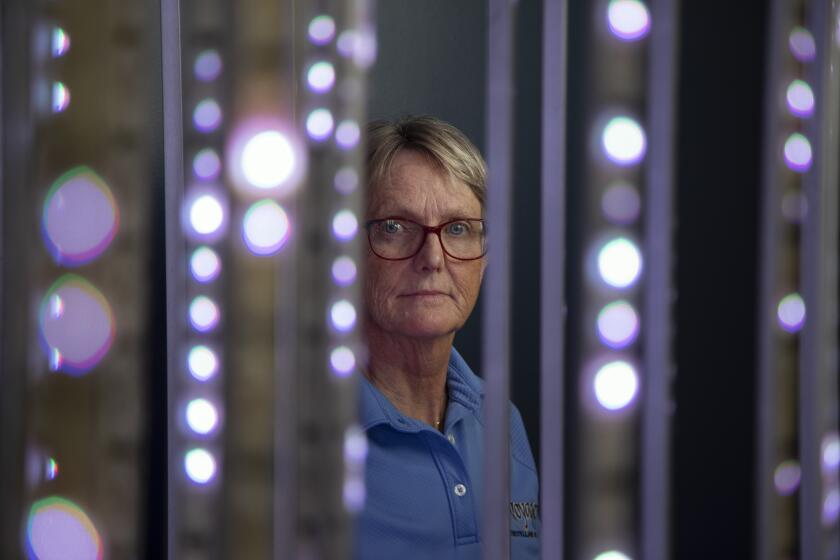
JPL tries to keep Voyager space probes from disconnecting the world’s longest phone call
Keeping in touch with NASA’s two aging Voyager spacecraft is getting harder to do as they get farther away and their power sources dwindle.
Sept. 3, 2022
More to Read

Too expensive, too slow: NASA asks for help with JPL’s Mars Sample Return mission
April 15, 2024

NASA’s attempt to bring home part of Mars is unprecedented. The mission’s problems are not
March 25, 2024
Budget deal for NASA offers glimmer of hope for JPL’s Mars Sample Return mission
March 6, 2024

Corinne Purtill is a science and medicine reporter for the Los Angeles Times. Her writing on science and human behavior has appeared in the New Yorker, the New York Times, Time Magazine, the BBC, Quartz and elsewhere. Before joining The Times, she worked as the senior London correspondent for GlobalPost (now PRI) and as a reporter and assignment editor at the Cambodia Daily in Phnom Penh. She is a native of Southern California and a graduate of Stanford University.
More From the Los Angeles Times

World & Nation
Harvey Weinstein rape conviction overturned by N.Y. Court of Appeals

Twerking vandals cause more than $25,000 in damage to Glendora cleaner’s cars
April 25, 2024

Serra High space team seeks to turn school into science destination

How athletes and entertainers like Shohei Ohtani get financially duped by those they trust

Voyager 1 talking to Earth again after NASA engineers 24 billion kilometres away devise software fix
NASA's Voyager 1 probe — the most distant man-made object in the universe — is returning usable information to ground control following months of spouting gibberish, the US space agency says.
The spaceship stopped sending readable data back to Earth on November 14, 2023, even though controllers could tell it was still receiving their commands.
In March, teams working at NASA's Jet Propulsion Laboratory discovered that a single malfunctioning chip was to blame.
They then had to devise a clever coding fix that worked within the tight memory constraints of its 46-year-old computer system.
"There was a section of the computer memory no longer working," project leader Dr Linda Spilker told the ABC.
"So we had to reprogram what was in that memory, move it to a different location, link everything back together and send everything up in a patch.
"And then on Saturday morning, we watched as Voyager 1 sent its first commands back and we knew we were back in communication once again."
Dr Spilker said they were receiving engineering data, so they knew the health and safety of the spacecraft.
"The next step is going to be to develop a patch so we can send back the science data," she said.
"That will really be exciting, to once again learn about interstellar space and what has been going on there that we've missed since November."
Dr Spilker said Voyager sent back data in real time, so the team had no facility to retrieve data covering the time since transmission was lost.
Launched in 1977, Voyager 1 was mankind's first spacecraft to enter the interstellar medium , in 2012, and is currently more than 24 billion kilometres from Earth.
Messages sent from Earth take about 22.5 hours to reach the spacecraft.
Its twin, Voyager 2, also left the solar system in 2018 as it was tracked by Australia's Parkes radio telescope.
Australia was also vital to a 2023 search for Voyager 2 after signals were lost, with Canberra's Deep Space Communication Complex monitoring for signals and then sending a successful command to shift the spacecraft's antenna 2 degrees .
Both Voyager spacecraft carry " Golden Records ": 12-inch, gold-plated copper disks intended to convey the story of our world to extraterrestrials.
These include a map of our solar system, a piece of uranium that serves as a radioactive clock allowing recipients to date the spaceship's launch, and symbolic instructions that convey how to play the record.
The contents of the record, selected for NASA by a committee chaired by legendary astronomer Carl Sagan, include encoded images of life on Earth, as well as music and sounds that can be played using an included stylus.
Their power banks were expected to be depleted sometime after 2025, but Dr Spilker said several systems had been turned off, so they were hopeful the two spacecraft would function into the 2030s.
They will then continue to wander the Milky Way, potentially for eternity, in silence.
- X (formerly Twitter)
Related Stories
Nasa restores contact with missing voyager 2 spacecraft after weeks of silence.
How songs from tiny villages in the Pacific are now floating in outer space
Voyager 1 spacecraft enters interstellar space
- Astronomy (Space)
- Computer Science
- Space Exploration
- United States
The most distant spacecraft in the solar system — Where are they now?
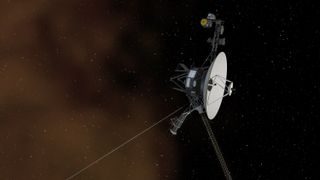
Humans have been flinging things into deep space for 50 years now, since the 1972 launch of Pioneer 10. We now have five spacecraft that have either reached the edges of our solar system or are fast approaching it: Pioneer 10, Pioneer 11, Voyager 1, Voyager 2 and New Horizons.
Most of these probes have defied their expected deaths and are still operating long beyond their original mission plans. These spacecraft were originally planned to explore our neighboring planets, but now they're blazing a trail out of the solar system , providing astronomers with unique vantage points in space — and they've been up to a lot in 2022.
Voyagers 1 and 2
The Voyager missions celebrated a very special anniversary this year: 45 years of operations . From close fly-bys of the outer planets to exploring humans' furthest reach in space, these two spacecraft have contributed immensely to astronomers' understanding of the solar system.
Related : Voyager: 15 incredible images of our solar system captured by the twin probes (gallery)
Their main project now is exploring where the sun 's influence ends, and other stars' influences begin. Voyager 1 crossed the heliopause, the boundary where the sun's flow of particles ceases to be the most important influence, in 2012 with Voyager 2 following close after, in 2018.
"Voyager 1 has now been in interstellar space for a decade…and it's still going, still going strong," Linda Spilker, Voyager project scientist and a planetary scientist at NASA's Jet Propulsion Laboratory (JPL) in California, told Space.com.
The mission team hit one major hiccup this year, when the spacecraft began sending home garbled information about its location. The engineers found the cause — the spacecraft was using a bad piece of computer hardware when it shouldn't have — and restored operations.
Get the Space.com Newsletter
Breaking space news, the latest updates on rocket launches, skywatching events and more!
These kinds of incidents are to be expected with an aging spacecraft, though. The team is also actively managing the power supply onboard each spacecraft, which is dwindling each year as the probes' radioactive generators grow increasingly inefficient. This year, mission personnel turned off heaters keeping a number of scientific instruments on board warm in the harsh, cold environment of space — and, much to everyone's surprise, those instruments are still working perfectly well.
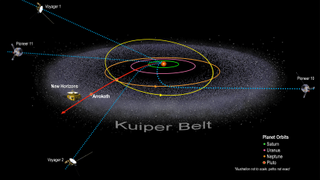
The cameras may have been turned off decades ago, but the spacecrafts' other instruments are collecting data on the plasma and magnetic fields from the sun at a great distance away from the star itself. Because particles of the solar wind — the constant stream of charged particles flowing off the sun — take time to travel such a long way, distant observations allow scientists to see how changes from the sun propagate throughout our cosmic neighborhood.
The edges of the solar system have been full of surprises, too. It would make sense that plasma from the sun becomes more sparse and spread out as you move away from the center of the solar system, but in fact, the Voyagers have encountered much denser plasma after crossing the heliopause. Astronomers are still puzzled about that one.
"It's just so amazing that even after all this time we continue to see the sun's influence in interstellar space," Spilker said. "I'm looking forward to Voyager continuing to operate, perhaps reaching the 50th anniversary."
Pioneers 10 and 11
The Pioneer spacecraft hold a special place in space history because of their role as, you guessed it, pioneers. Unfortunately, these milestone 50-year-old spacecraft are non-functional — Pioneer 10 lost communications back in 2003, and Pioneer 11 has been silent since its last contact in 1995.
But both these spacecraft are marks of humanity's presence in the solar system, and they are still continuing on their journeys, even if we're not sending them commands or firing their rockets anymore. Once a spacecraft is set on a trajectory out of the solar system, according to the laws of physics, it won't stop unless something changes its course.
New Horizons
New Horizons is by far the youngest sibling of these groundbreaking missions, having just launched in 2006 . After completing its famous flyby of dwarf planet Pluto in 2015 , this probe has been zooming out of the solar system at record speed, set to reach the heliopause around 2040.
Not only has it completed its primary mission, but it successfully completed a flyby of the smaller Kuiper Belt object, Arrokoth , in 2019 as its first mission extension. Earlier this year, the spacecraft was put into hibernation mode because an extended mission hadn't yet been approved. But now, the team is excitedly moving into New Horizons' 2nd Kuiper Belt Extended Mission, or KEM2 for short. KEM2 began on Oct. 1 , although the spacecraft will hibernate until March 1, 2023.
In the meantime, the mission team is preparing for exciting new observations. With cutting-edge instruments — far more advanced than what the Voyagers carried in the 1970s — the team is prepared to use New Horizons as a powerhouse observatory in the distant solar system, providing a viewpoint we can't achieve here on Earth .
Bonnie Burrati, planetary scientist at JPL and member of the New Horizons team, is particularly looking forward to new views of Kuiper Belt objects (KBOs), the chunks of ice and rock beyond Neptune . New Horizons' unique position in the outer solar system provides new angles of looking at these KBOs, she said. Different views can tell astronomers about how rough the objects' surfaces are, among other things, based on how light scatters and creates shadows on them.
Another planetary scientist on the team from Southwest Research Institute in Colorado, Leslie Young, wants to use the spacecraft for a new look at something closer to home: the ice giants, Uranus and Neptune. New Horizons’ unique viewpoint provides scientists with information about how light scatters through the planets’ atmospheres—information we can’t get from here on Earth, since we can’t see Uranus and Neptune from that angle. Planetary scientists are eager for more information about these planets, especially as NASA begins planning for a new mission to visit Uranus.
— The icy 'space snowman' Arrokoth in deep space just got names for its best features — Pale Blue Dot at 30: Voyager 1's iconic photo of Earth from space reveals our place in the universe — Destination Pluto: NASA's New Horizons mission in pictures
When the spacecraft wakes from hibernation, it will be past the so-called "Kuiper cliff," where scientists currently think there are far fewer large KBOs. "When we look at other star systems, we see debris disks extending to much larger distances from their host stars," Bryan Holler, an astronomer at Baltimore's Space Telescope Science Institute, told Space.com. "If ET were to look at our solar system, would they see the same thing?"
This next extended mission will even venture beyond New Horizons' original domain of planetary science. Now, the spacecraft will provide better-than-ever measurements of the background of light and cosmic rays in space, trace the distributions of dust throughout our solar system, and obtain crucial information on the sun's influence, complimentary to the Voyagers. Since the three functional far out spacecraft are heading in separate directions, they allow astronomers to map out irregularities in the solar system's structure.
Luckily for New Horizons, signs indicate that the spacecraft will have enough power to last through the 2040s and possibly beyond — each year, moving 300 million miles (480 million kilometers) farther into uncharted territory.
Follow the author at @ briles_34 on Twitter. Follow us on Twitter @ Spacedotcom and on Facebook .
Join our Space Forums to keep talking space on the latest missions, night sky and more! And if you have a news tip, correction or comment, let us know at: [email protected].

Briley Lewis (she/her) is a freelance science writer and Ph.D. Candidate/NSF Fellow at the University of California, Los Angeles studying Astronomy & Astrophysics. Follow her on Twitter @briles_34 or visit her website www.briley-lewis.com .
Satellites watch as 4th global coral bleaching event unfolds (image)
Happy Earth Day 2024! NASA picks 6 new airborne missions to study our changing planet
NASA ends CloudSat Earth-observing mission after 18 years
- bolide I wonder if the JWST could see any of these satellites, if it aimed in their direction. Reply
bolide said: I wonder if the JWST could see any of these satellites, if it aimed in their direction.
- View All 2 Comments
Most Popular
- 2 Earth's weird 'quasi-moon' Kamo'oalewa is a fragment blasted out of big moon crater
- 3 Fortnite launches to the moon in new 'Lunar Horizons' simulation game
- 4 NASA astronauts enter quarantine for 1st crewed Boeing Starliner launch on May 6
- 5 Building rockets and looking for life on Venus: Q&A with Rocket Lab's Peter Beck
share this!
April 22, 2024
This article has been reviewed according to Science X's editorial process and policies . Editors have highlighted the following attributes while ensuring the content's credibility:
fact-checked
trusted source
NASA's Voyager 1 resumes sending engineering updates to Earth

For the first time since November, NASA's Voyager 1 spacecraft is returning usable data about the health and status of its onboard engineering systems. The next step is to enable the spacecraft to begin returning science data again. The probe and its twin, Voyager 2, are the only spacecraft to ever fly in interstellar space (the space between stars).
Voyager 1 stopped sending readable science and engineering data back to Earth on Nov. 14, 2023, even though mission controllers could tell the spacecraft was still receiving their commands and otherwise operating normally. In March, the Voyager engineering team at NASA's Jet Propulsion Laboratory in Southern California confirmed that the issue was tied to one of the spacecraft's three onboard computers, called the flight data subsystem (FDS). The FDS is responsible for packaging the science and engineering data before it's sent to Earth.
The team discovered that a single chip responsible for storing a portion of the FDS memory—including some of the FDS computer's software code—isn't working. The loss of that code rendered the science and engineering data unusable. Unable to repair the chip, the team decided to place the affected code elsewhere in the FDS memory. But no single location is large enough to hold the section of code in its entirety.
So they devised a plan to divide the affected code into sections and store those sections in different places in the FDS. To make this plan work, they also needed to adjust those code sections to ensure, for example, that they all still function as a whole. Any references to the location of that code in other parts of the FDS memory needed to be updated as well.

The team started by singling out the code responsible for packaging the spacecraft's engineering data. They sent it to its new location in the FDS memory on April 18. A radio signal takes about 22.5 hours to reach Voyager 1, which is over 15 billion miles (24 billion kilometers) from Earth, and another 22.5 hours for a signal to come back to Earth. When the mission flight team heard back from the spacecraft on April 20, they saw that the modification had worked: For the first time in five months, they were able to check the health and status of the spacecraft.
During the coming weeks, the team will relocate and adjust the other affected portions of the FDS software. These include the portions that will start returning science data.
Voyager 2 continues to operate normally. Launched over 46 years ago, the twin Voyager spacecraft are the longest-running and most distant spacecraft in history. Before the start of their interstellar exploration, both probes flew by Saturn and Jupiter, and Voyager 2 flew by Uranus and Neptune.
Provided by NASA
Explore further
Feedback to editors

First experimental proof for brain-like computer with water and salt
9 minutes ago

Airborne single-photon lidar system achieves high-resolution 3D imaging
12 minutes ago

The magic of voices: Why we like some singers' voices and not others
18 minutes ago

Chemical rope trick at molecular level: Mechanism research helps when 'trial and error' fails
24 minutes ago

Targeted culling of starfish found to help Great Barrier Reef maintain or increase cover
36 minutes ago

How do birds flock? Researchers do the math to reveal previously unknown aerodynamic phenomenon
42 minutes ago

Archaeologists unearth top half of statue of Ramesses II

Scientists discover method to prevent coalescence in immiscible liquids

Recently discovered black hole is part of a nearby disrupted star cluster, study finds

Demonstration of heralded three-photon entanglement on a photonic chip
3 hours ago
Relevant PhysicsForums posts
Waves in space.
59 minutes ago
'Devil' comet visible tonight 21.04.24
2 hours ago
Solar Activity and Space Weather Update thread
15 hours ago
Our Beautiful Universe - Photos and Videos
17 hours ago
Documenting the setup of my new telescope
Apr 24, 2024
What did I capture?
Apr 23, 2024
More from Astronomy and Astrophysics
Related Stories

Engineers working to resolve issue with Voyager 1 computer
Dec 13, 2023

NASA hears signal from Voyager 2 spacecraft after mistakenly cutting contact
Aug 1, 2023

NASA listens for Voyager 2 spacecraft after wrong command cuts contact
Jul 31, 2023

NASA's Voyager team focuses on software patch, thrusters
Oct 20, 2023

NASA's Voyager will do more science with new power strategy
Apr 27, 2023

Engineers investigating NASA's Voyager 1 telemetry data
May 18, 2022
Recommended for you

Japan's moon lander wasn't built to survive a weekslong lunar night. It's still going after 3

Simulated microgravity affects sleep and physiological rhythms, study finds
Apr 22, 2024

'Tube map' around planets and moons made possible by knot theory
Apr 17, 2024

NASA's Ingenuity Mars helicopter team says goodbye—for now

NASA confirms mystery object that crashed through roof of Florida home came from space station
Apr 16, 2024

NASA is seeking a faster, cheaper way to bring Mars samples to Earth
Let us know if there is a problem with our content.
Use this form if you have come across a typo, inaccuracy or would like to send an edit request for the content on this page. For general inquiries, please use our contact form . For general feedback, use the public comments section below (please adhere to guidelines ).
Please select the most appropriate category to facilitate processing of your request
Thank you for taking time to provide your feedback to the editors.
Your feedback is important to us. However, we do not guarantee individual replies due to the high volume of messages.
E-mail the story
Your email address is used only to let the recipient know who sent the email. Neither your address nor the recipient's address will be used for any other purpose. The information you enter will appear in your e-mail message and is not retained by Phys.org in any form.
Newsletter sign up
Get weekly and/or daily updates delivered to your inbox. You can unsubscribe at any time and we'll never share your details to third parties.
More information Privacy policy
Donate and enjoy an ad-free experience
We keep our content available to everyone. Consider supporting Science X's mission by getting a premium account.
E-mail newsletter
NASA Voyager 1 Encounters New Region in Deep Space

NASA's Voyager 1 spacecraft has entered a new region at the far reaches of our solar system that scientists feel is the final area the spacecraft has to cross before reaching interstellar space.
Scientists refer to this new region as a magnetic highway for charged particles because our sun's magnetic field lines are connected to interstellar magnetic field lines. This connection allows lower-energy charged particles that originate from inside our heliosphere -- or the bubble of charged particles the sun blows around itself -- to zoom out and allows higher-energy particles from outside to stream in. Before entering this region, the charged particles bounced around in all directions, as if trapped on local roads inside the heliosphere.
The Voyager team infers this region is still inside our solar bubble because the direction of the magnetic field lines has not changed. The direction of these magnetic field lines is predicted to change when Voyager breaks through to interstellar space. The new results were described at the American Geophysical Union meeting in San Francisco on Monday.
"Although Voyager 1 still is inside the sun's environment, we now can taste what it's like on the outside because the particles are zipping in and out on this magnetic highway," said Edward Stone, Voyager project scientist based at the California Institute of Technology, Pasadena. "We believe this is the last leg of our journey to interstellar space. Our best guess is it's likely just a few months to a couple years away. The new region isn't what we expected, but we've come to expect the unexpected from Voyager." Since December 2004, when Voyager 1 crossed a point in space called the termination shock, the spacecraft has been exploring the heliosphere's outer layer, called the heliosheath. In this region, the stream of charged particles from the sun, known as the solar wind, abruptly slowed down from supersonic speeds and became turbulent. Voyager 1's environment was consistent for about five and a half years. The spacecraft then detected that the outward speed of the solar wind slowed to zero. The intensity of the magnetic field also began to increase at that time. Voyager data from two onboard instruments that measure charged particles showed the spacecraft first entered this magnetic highway region on July 28, 2012. The region ebbed away and flowed toward Voyager 1 several times. The spacecraft entered the region again Aug. 25 and the environment has been stable since. "If we were judging by the charged particle data alone, I would have thought we were outside the heliosphere," said Stamatios Krimigis, principal investigator of the low-energy charged particle instrument, based at the Johns Hopkins Applied Physics Laboratory, Laurel, Md. "But we need to look at what all the instruments are telling us and only time will tell whether our interpretations about this frontier are correct." Spacecraft data revealed the magnetic field became stronger each time Voyager entered the highway region; however, the direction of the magnetic field lines did not change. "We are in a magnetic region unlike any we've been in before -- about 10 times more intense than before the termination shock -- but the magnetic field data show no indication we're in interstellar space," said Leonard Burlaga, a Voyager magnetometer team member based at NASA's Goddard Space Flight Center in Greenbelt, Md. "The magnetic field data turned out to be the key to pinpointing when we crossed the termination shock. And we expect these data will tell us when we first reach interstellar space." Voyager 1 and 2 were launched 16 days apart in 1977. At least one of the spacecraft has visited Jupiter, Saturn, Uranus and Neptune. Voyager 1 is the most distant human-made object, about 11 billion miles (18 billion kilometers) away from the sun. The signal from Voyager 1 takes approximately 17 hours to travel to Earth. Voyager 2, the longest continuously operated spacecraft, is about 9 billion miles (15 billion kilometers) away from our sun. While Voyager 2 has seen changes similar to those seen by Voyager 1, the changes are much more gradual. Scientists do not think Voyager 2 has reached the magnetic highway. The Voyager spacecraft were built and continue to be operated by NASA's Jet Propulsion Laboratory, in Pasadena, Calif. Caltech manages JPL for NASA. The Voyager missions are a part of NASA's Heliophysics System Observatory, sponsored by the Heliophysics Division of the Science Mission Directorate at NASA Headquarters in Washington. For more information about the Voyager spacecraft, visit: http://www.nasa.gov/voyager and http://voyager.jpl.nasa.gov .
News Media Contact
Jia-Rui Cook
Jet Propulsion Laboratory, Pasadena, Calif.
818-354-0724
Dwayne Brown
202-358-1726

Hubble Provides Interstellar Road Map for Voyagers’ Galactic Trek
NASA’s two Voyager spacecraft are hurtling through unexplored territory on their road trip beyond our solar system. Along the way, they are measuring the interstellar medium, the mysterious environment between stars. NASA’s Hubble Space Telescope is providing the road map – by measuring the material along the probes’ future trajectories. Even after the Voyagers run out of electrical power and are unable to send back new data, which may happen in about a decade, astronomers can use Hubble observations to characterize the environment through which these silent ambassadors will glide.
A preliminary analysis of the Hubble observations reveals a rich, complex interstellar ecology, containing multiple clouds of hydrogen laced with other elements. Hubble data, combined with the Voyagers, have also provided new insights into how our sun travels through interstellar space.
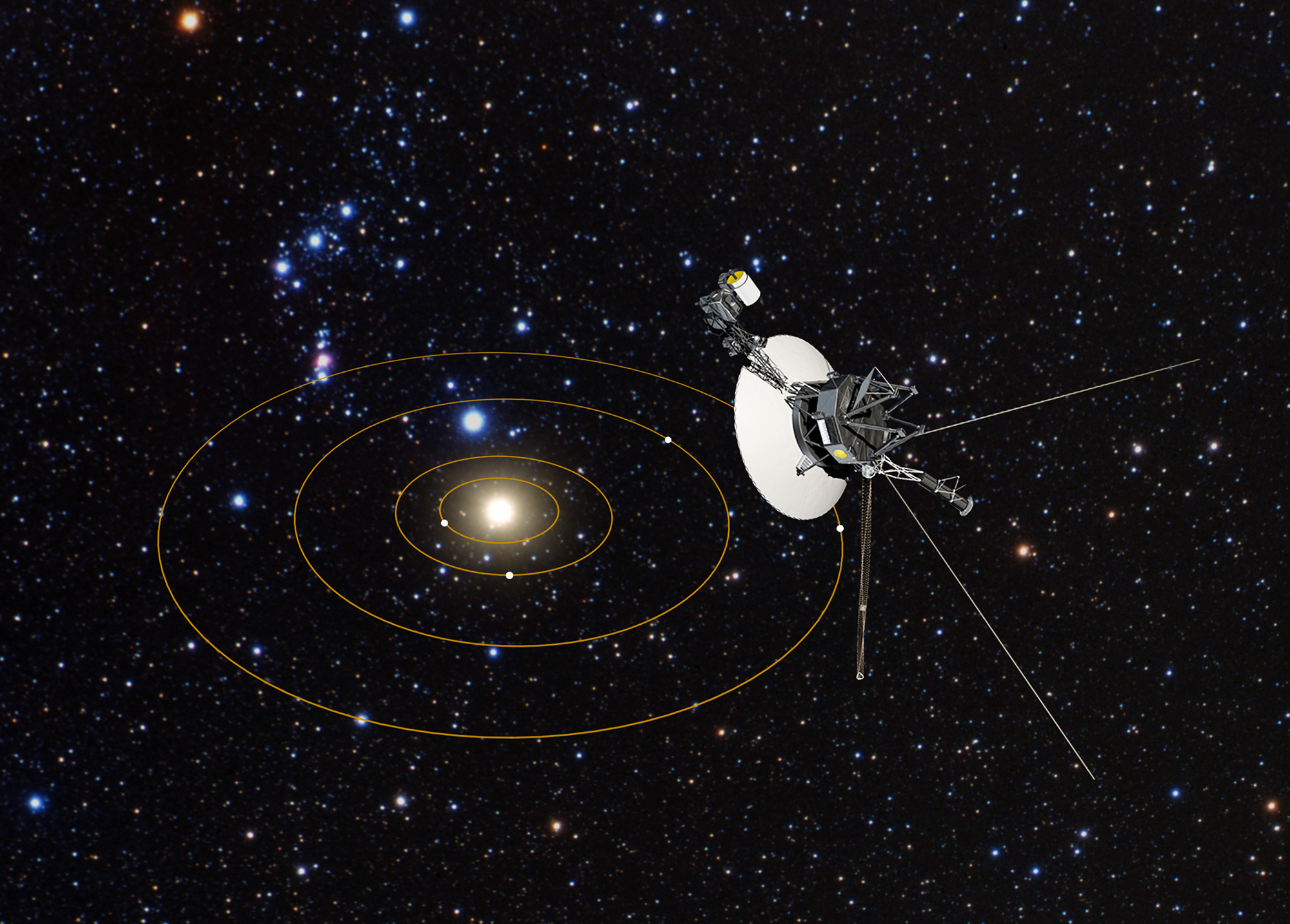
“This is a great opportunity to compare data from in situ measurements of the space environment by the Voyager spacecraft and telescopic measurements by Hubble,” said study leader Seth Redfield of Wesleyan University in Middletown, Connecticut. “The Voyagers are sampling tiny regions as they plow through space at roughly 38,000 miles per hour. But we have no idea if these small areas are typical or rare. The Hubble observations give us a broader view because the telescope is looking along a longer and wider path. So Hubble gives context to what each Voyager is passing through.”
The astronomers hope that the Hubble observations will help them characterize the physical properties of the local interstellar medium. “Ideally, synthesizing these insights with in situ measurements from Voyager would provide an unprecedented overview of the local interstellar environment,” said Hubble team member Julia Zachary of Wesleyan University.
The team’s results will be presented Jan. 6 at the winter meeting of the American Astronomical Society in Grapevine, Texas.
NASA launched the twin Voyager 1 and 2 spacecraft in 1977. Both explored the outer planets Jupiter and Saturn. Voyager 2 went on to visit Uranus and Neptune.
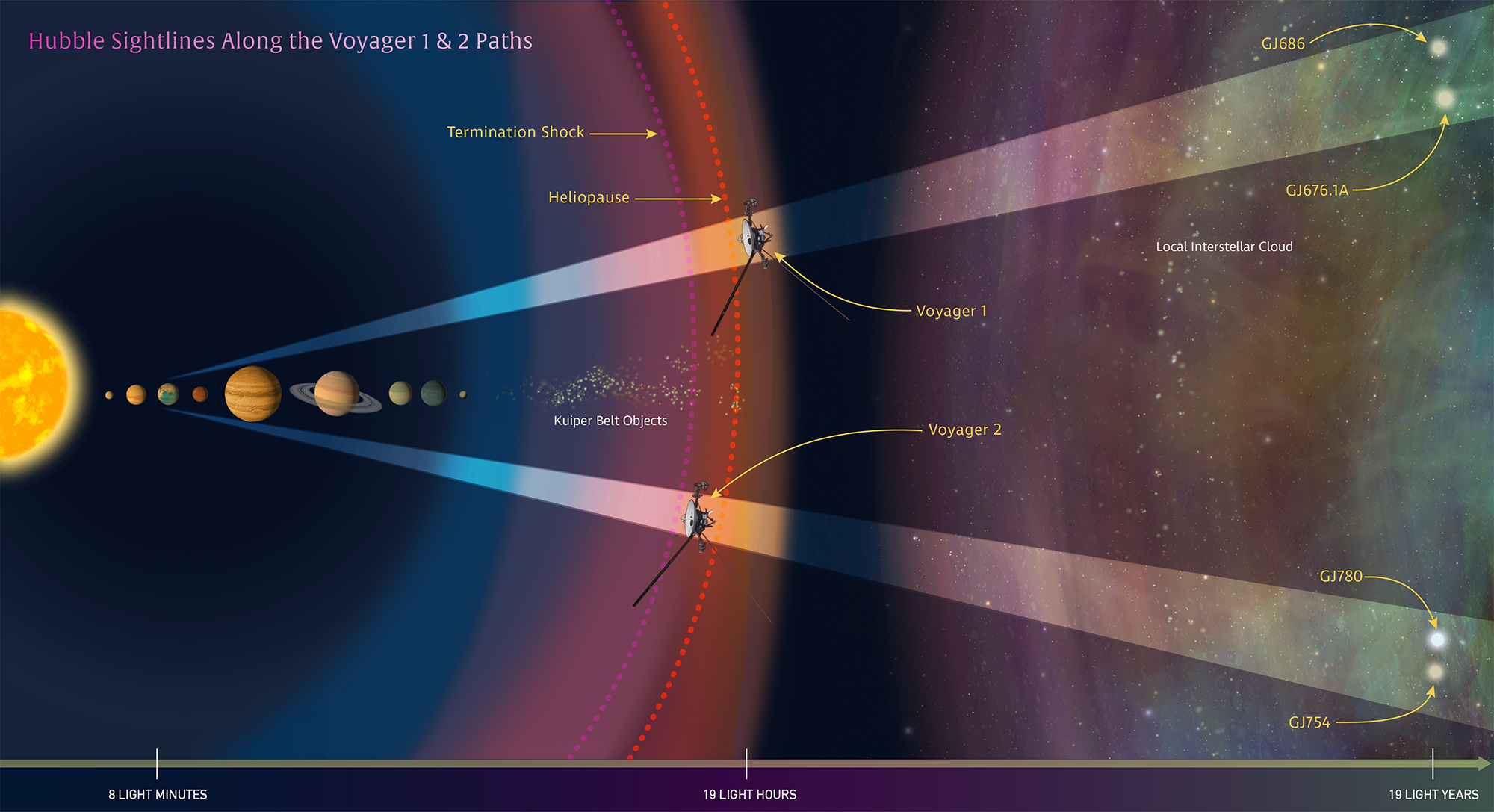
The pioneering Voyager spacecraft are currently exploring the outermost edge of the sun’s domain . Voyager 1 is now zooming through interstellar space, the region between the stars that is filled with gas, dust, and material recycled from dying stars.
Voyager 1 is 13 billion miles from Earth, making it the farthest human-made object ever built. In about 40,000 years, after the spacecraft will no longer be operational and will not be able to gather new data, it will pass within 1.6 light-years of the star Gliese 445, in the constellation Camelopardalis. Its twin, Voyager 2, is 10.5 billion miles from Earth, and will pass 1.7 light-years from the star Ross 248 in about 40,000 years.
For the next 10 years, the Voyagers will be making measurements of interstellar material, magnetic fields and cosmic rays along their trajectories. Hubble complements the Voyagers’ observations by gazing at two sight lines along each spacecraft’s path to map interstellar structure along their star-bound routes. Each sight line stretches several light-years to nearby stars. Sampling the light from those stars, Hubble’s Space Telescope Imaging Spectrograph measures how interstellar material absorbs some of the starlight, leaving telltale spectral fingerprints.
Hubble found that Voyager 2 will move out of the interstellar cloud that surrounds the solar system in a couple thousand years. The astronomers, based on Hubble data, predict that the spacecraft will spend 90,000 years in a second cloud and pass into a third interstellar cloud.
An inventory of the clouds’ composition reveals slight variations in the abundances of the chemical elements contained in the structures. “These variations could mean the clouds formed in different ways, or from different areas, and then came together,” Redfield said.
An initial look at the Hubble data also suggests that the sun is passing through clumpier material in nearby space, which may affect the heliosphere, the large bubble containing our solar system that is produced by our sun’s powerful solar wind. At its boundary, called the heliopause, the solar wind pushes outward against the interstellar medium. Hubble and Voyager 1 made measurements of the interstellar environment beyond this boundary, where the wind comes from stars other than our sun.
“I’m really intrigued by the interaction between stars and the interstellar environment,” Redfield said. “These kinds of interactions are happening around most stars, and it is a dynamic process.”
The heliosphere is compressed when the sun moves through dense material, but it expands back out when the star passes through low-density matter. This expansion and contraction is caused by the interaction between the outward pressure of the stellar wind, composed of a stream of charged particles, and the pressure of the interstellar material surrounding a star.
The Hubble Space Telescope is a project of international cooperation between NASA and the European Space Agency. NASA's Goddard Space Flight Center in Greenbelt, Maryland, manages the telescope. The Space Telescope Science Institute (STScI) in Baltimore, Maryland, conducts Hubble science operations. STScI is operated for NASA by the Association of Universities for Research in Astronomy in Washington, D.C. The Voyagers were built by JPL, which continues to operate both spacecraft. JPL is a division of Caltech.
For images and more information about the local interstellar medium and Hubble, visit: http://www.nasa.gov/hubble
For more information about the Voyager mission, visit: www.nasa.gov/voyager
For additional information, contact:
Felicia Chou NASA Headquarters, Washington, D.C. 202-358-0257 [email protected]
Donna Weaver / Ray Villard Space Telescope Science Institute, Baltimore, Maryland 410-338-4493 / 410-338-4514 [email protected] / [email protected]
Elizabeth Landau Jet Propulsion Laboratory, Pasadena, Calif. 818-354-6425 [email protected]
Seth Redfield Wesleyan University, Middletown, Connecticut 860-685-3669 [email protected]
Related Terms
- Astrophysics
- Goddard Space Flight Center
- Hubble Space Telescope
Explore More

NASA’s Planet-Hunting Satellite Temporarily on Pause
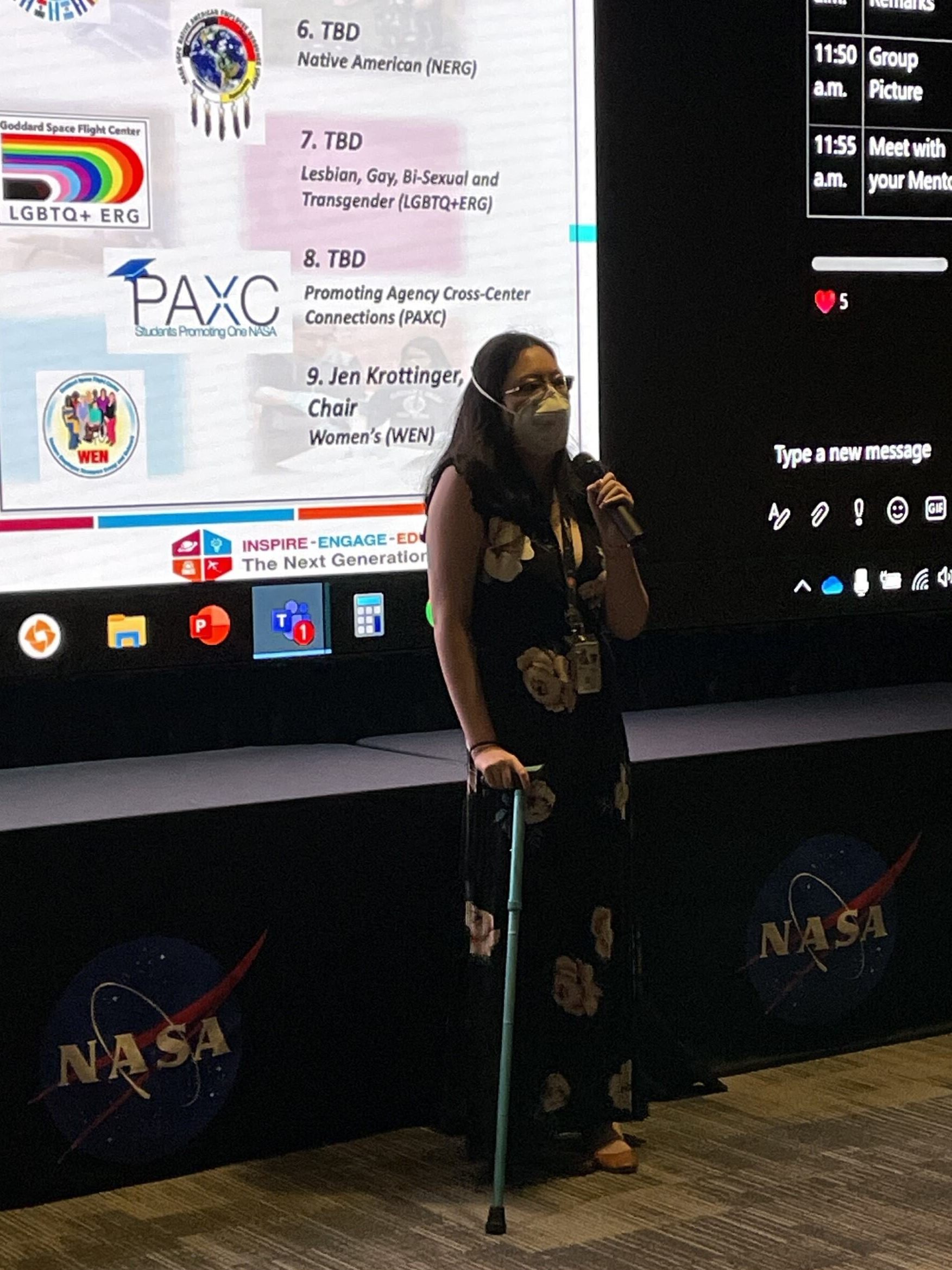
Kiyun Kim: From Intern to Accessibility Advocate
Kiyun Kim began at Goddard as a summer intern. Impressed by the center’s community bonds, Kim is now co-chair of a center resource group that champions accessibility and inclusivity. Name: Kiyun KimTitle: Software EngineerOrganization: Ground Software Systems Branch (Code 583) What do you do at Goddard Space Flight Center? I’m a software engineer on the […]
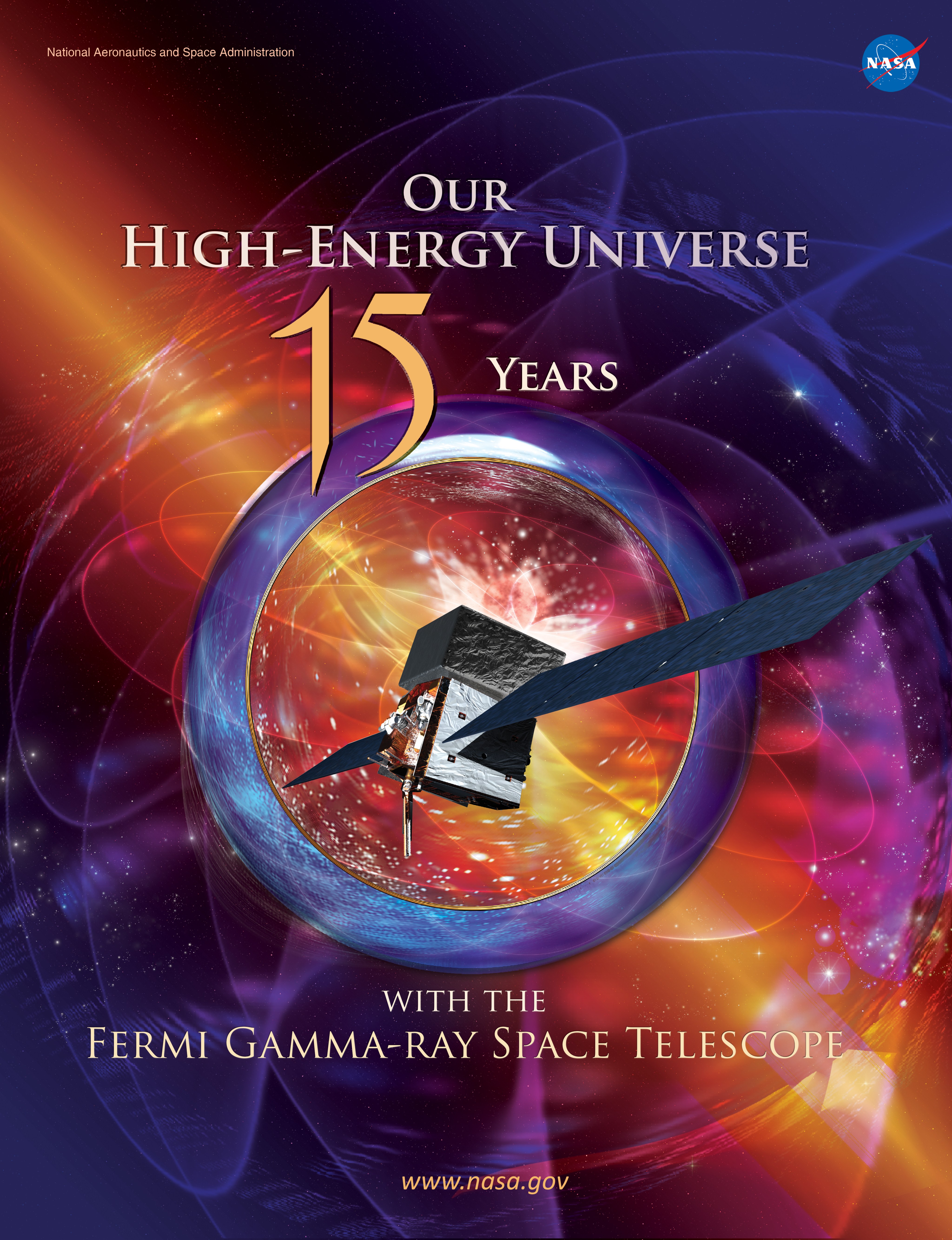
Explore the Universe with the First E-Book from NASA’s Fermi
Discover more topics from nasa.
James Webb Space Telescope

Perseverance Rover

Parker Solar Probe

More From Forbes
Nasa celebrates as 1977’s voyager 1 phones home at last.
- Share to Facebook
- Share to Twitter
- Share to Linkedin
NASA’s Voyager 1 spacecraft is depicted in this artist’s concept traveling through interstellar ... [+] space, or the space between stars, which it entered in 2012.
Voyager 1 has finally returned usable data to NASA from outside the solar system after five months offline.
Launched in 1977 and now in its 46th year, the probe has been suffering from communication issues since November 14. The same thing also happened in 2022 . However, this week, NASA said that engineers were finally able to get usable data about the health and status of its onboard engineering systems.
Fixing Voyager 1 has been slow work. It’s currently over 15 billion miles (24 billion kilometers) from Earth, which means a radio message takes about 22.5 hours to reach it—and the same again to receive an answer.
The problem appears to have been its flight data subsystem, one of the spacecraft’s three onboard computers. Its job is to package the science and engineering data before it’s sent to Earth. Since the computer chip that stores its memory and some of its code is broken, engineers had to reinsert that code into a new location.
Next up for engineers at NASA’s Jet Propulsion Laboratory in California is to adjust other parts of the FDS software so Voyager 1 can resume sending science data.
Apple iPhone 16 Unique All New Design Promised In New Report
Huawei s pura 70 ultra beats iphone with pioneering new feature, meet the fintech billionaire making a fortune rewarding home renters, beyond the ‘heliopause’.
The longest-running and most distant spacecraft in history, Voyager 1, was launched on September 5, 1977, while its twin spacecraft, Voyager 2, was launched a little earlier, on August 20, 1977. Voyager 2—now 12 billion miles away and traveling more slowly—continues to operate normally.
Both are now beyond what astronomers call the heliopause—a protective bubble of particles and magnetic fields created by the sun, which is thought to represent the sun’s farthest influence. Voyager 1 got to the heliopause in 2012 and Voyager 2 in 2018.
The Pale Blue Dot is a photograph of Earth taken Feb. 14, 1990, by NASA’s Voyager 1 at a distance of ... [+] 3.7 billion miles (6 billion kilometers) from the sun. The image inspired the title of scientist Carl Sagan's book, "Pale Blue Dot: A Vision of the Human Future in Space," in which he wrote: "Look again at that dot. That's here. That's home. That's us."
Pale Blue Dot
Since their launch from Cape Canaveral, Florida, aboard Titan-Centaur rockets, Voyager 1 and Voyager 2 have had glittering careers. Both photographed Jupiter and Saturn in 1979 and 1980 before going their separate ways. Voyager 1 could have visited Pluto, but that was sacrificed so scientists could get images of Saturn’s moon, Titan, a maneuver that made it impossible for it to reach any other body in the solar system. Meanwhile, Voyager 2 took slingshots around the planets to also image Uranus in 1986 and Neptune in 1989—the only spacecraft ever to image the two outer planets.
On February 14, 1990, when 3.7 billion miles from Earth, Voyager 1 turned its cameras back toward the sun and took an image that included our planet as “a mote of dust suspended in a sunbeam.” Known as the “Pale Blue Dot,” it’s one of the most famous photos ever taken. It was remastered in 2019 .
Wishing you clear skies and wide eyes.

- Editorial Standards
- Reprints & Permissions

IMAGES
VIDEO
COMMENTS
Note: Because Earth moves around the sun faster than Voyager 1 is speeding away from the inner solar system, the distance between Earth and the spacecraft actually decreases at certain times of year. Distance from Sun: This is a real-time indicator of Voyagers' straight-line distance from the sun in astronomical units (AU) and either miles (mi ...
Voyager 1 was the first spacecraft to cross the heliosphere, the boundary where the influences outside our solar system are stronger than those from our Sun. ... Like the plaques on Pioneers 10 and 11, the record has inscribed symbols to show the location of Earth relative to several pulsars. The records also contain instructions to play them ...
Voyager 1 is a space probe launched by NASA on September 5, 1977, ... Voyager 1 was commanded to change its orientation to measure the sideways motion of the solar wind at that location in space in March 2011 (~33yr 6mo from launch). A test roll done in February had confirmed the spacecraft's ability to maneuver and reorient itself.
Voyager 2 Present Position. This simulated view of the solar system allows you to explore the planets, moons, asteroids, comets, and spacecraft exploring our solar system. You can also fast-forward and rewind in real-time. NASA/JPL-Caltech.
Voyager 1 stopped sending readable science and engineering data back to Earth on Nov. 14, 2023, even though mission controllers could tell the spacecraft was still receiving their commands and otherwise operating normally. ... Any references to the location of that code in other parts of the FDS memory needed to be updated as well. The team ...
About the mission. Voyager 1 reached interstellar space in August 2012 and is the most distant human-made object in existence. Launched just shortly after its twin spacecraft, Voyager 2, in 1977, Voyager 1 explored the Jovian and Saturnian systems discovering new moons, active volcanoes and a wealth of data about the outer solar system.
This is a real-time indicator of Voyager 1's distance from Earth in astronomical units (AU) and either miles (mi) or kilometers (km). Note: Because Earth moves around the sun faster than Voyager 1 is speeding away from the inner solar system, the distance between Earth and the spacecraft actually decreases at certain times of year.
Mission Overview. The twin Voyager 1 and 2 spacecraft are exploring where nothing from Earth has flown before. Continuing on their more-than-40-year journey since their 1977 launches, they each are much farther away from Earth and the sun than Pluto. In August 2012, Voyager 1 made the historic entry into interstellar space, the region between ...
Voyager 1 is literally venturing into the great unknown and is approaching interstellar space. Traveling at a speed of about one million miles per day, Voyager 1 could cross into interstellar space within the next 10 years. "Interstellar space is filled with material ejected by explosions of nearby stars," Stone said.
In August 2012, Voyager 1 made the historic entry into interstellar space, the region between stars, filled with material ejected by the death of nearby stars millions of years ago. Voyager 2 entered interstellar space on November 5, 2018 and scientists hope to learn more about this region. Both spacecraft are still sending scientific ...
Voyager 1 live position and data. This page shows Voyager 1 location and other relevant astronomical data in real time. The celestial coordinates, magnitude, distances and speed are updated in real time and are computed using high quality data sets provided by the JPL Horizons ephemeris service (see acknowledgements for details). The sky map shown in the background represents a rectangular ...
Voyager 1 is the first spacecraft to travel beyond the solar system and reach interstellar space . The probe launched on Sept. 5, 1977 — about two weeks after its twin Voyager 2 — and as of ...
This visualization tracks the trajectory of the Voyager 1 spacecraft through the solar system. Launched on September 5, 1977, it was one of two spacecraft sent to visit the giant planets of the outer solar system. Voyager 1 flew by Jupiter and Saturn before being directed out of the solar system.To fit the 40 year history of the mission into a short visualization, the pacing of time ...
The Voyager 1 and Voyager 2 probes launched in 1977 on a mission to study Jupiter and Saturn but continued onward through the outer reaches of the solar system. In 2012, Voyager 1 became the first ...
Voyager 2 is now more than 96 AU from the sun, traveling at a speed of 15.5 kilometers per second (9.6 miles per second). Both spacecraft are moving considerably faster than Pioneers 10 and 11, two earlier spacecraft that became the first robotic visitors to fly past Jupiter and Saturn in the mid-70s. This processed color image of Jupiter was ...
Today, 45 years after its launch and 14.6 billion miles from Earth, four of Voyager 1's 11 instruments continue to return useful data, having now spent 10 years in interstellar space. Signals from the spacecraft take nearly 22 hours to reach Earth, and 22 hours for Earth-based signals to reach the spacecraft.
Voyager 1, seen in an artist's rendering, is the farthest human-made object from Earth, some 15 billion miles away. That complicates troubleshooting.
Voyager 1 and its twin Voyager 2 are the only spacecraft ever to operate outside the heliosphere, the protective bubble of particles and magnetic fields generated by the Sun. Voyager 1 reached the interstellar boundary in 2012, while Voyager 2 (traveling slower and in a different direction than its twin) reached it in 2018.
Voyager 1, robotic U.S. interplanetary probe launched in 1977 that visited Jupiter and Saturn and was the first spacecraft to reach interstellar space. Voyager 1 swung by Jupiter on March 5, 1979, and then headed for Saturn, which it reached on November 12, 1980.
Voyager 1 flew within 64,200 kilometers (40,000 miles) of the cloud tops, while Voyager 2 came within 41,000 kilometers (26,000 miles). Saturn is the second largest planet in the solar system. It takes 29.5 Earth years to complete one orbit of the Sun, and its day was clocked at 10 hours, 39 minutes.
The consensus of the Voyager science team is that Voyager 1 has not yet reached interstellar space. "The Voyager team is aware of reports today that NASA's Voyager 1 has left the solar system," said Edward Stone, Voyager project scientist based at the California Institute of Technology, Pasadena, Calif. "It is the consensus of the Voyager ...
Voyager 1 and 2 are continuing out into space but will run out of battery power sometime after 2025, ... "So we had to reprogram what was in that memory, move it to a different location, link ...
We now have five spacecraft that have either reached the edges of our solar system or are fast approaching it: Pioneer 10, Pioneer 11, Voyager 1, Voyager 2 and New Horizons. Most of these probes ...
The probe and its twin, Voyager 2, are the only spacecraft to ever fly in interstellar space (the space between stars). Voyager 1 stopped sending readable science and engineering data back to ...
Jet Propulsion Laboratory, Pasadena, Calif. 818-354-0724. [email protected]. Dwayne Brown. 202-358-1726. [email protected]. 2012-381. NASA's Voyager 1 spacecraft has entered a new region at the far reaches of our solar system that scientists feel is the final area the spacecraft has to cross before reaching interstellar space.
In about 40,000 years, after the spacecraft will no longer be operational and will not be able to gather new data, it will pass within 1.6 light-years of the star Gliese 445, in the constellation Camelopardalis. Its twin, Voyager 2, is 10.5 billion miles from Earth, and will pass 1.7 light-years from the star Ross 248 in about 40,000 years.
NASA Voyager Status Update on Voyager 1 Location. Artist concept of NASA's Voyager spacecraft. Image credit: NASA/JPL-Caltech › larger image. "The Voyager team is aware of reports today that NASA's Voyager 1 has left the solar system," said Edward Stone, Voyager project scientist based at the California Institute of Technology, Pasadena, Calif.
Voyager 1 got to the heliopause in 2012 and Voyager 2 in 2018. The Pale Blue Dot is a photograph of Earth taken Feb. 14, 1990, by NASA's Voyager 1 at a distance of ... [+] 3.7 billion miles (6 ...